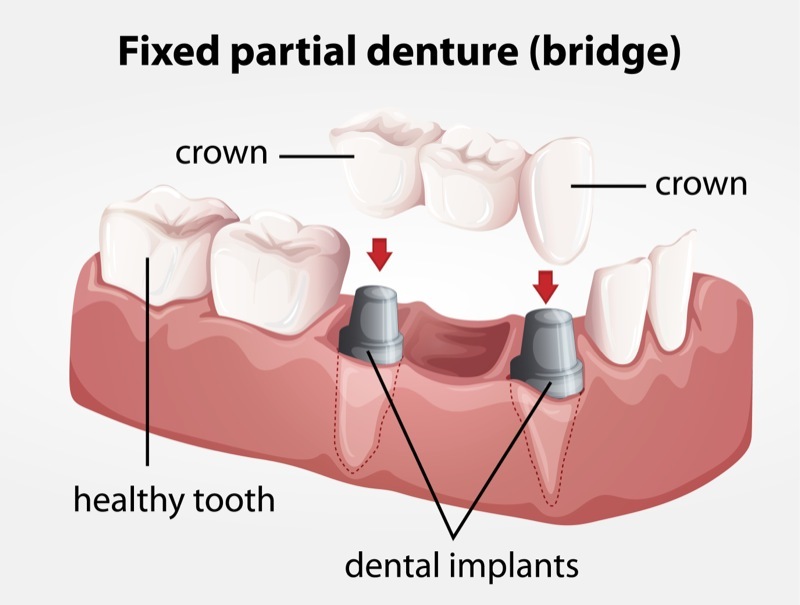Dental Bridges in Springfield & Longmeadow, MA
Trusted Dental Bridges Specialists in Springfield
What is a Dental Bridge?
Dental bridges have been a primary method of tooth replacement for several decades. The most common type of dental bridges are the fixed bridge, which includes an artificial tooth to fill the gap, and two crowns to anchor that tooth. Our practice is
extensively trained in all-ceramic dental bridges, which fill gaps with natural-looking artificial teeth, help minimize chewing and speaking problems, and provide overall added strength to the mouth.
What Can I Expect from the Dental Bridges Procedure?
Replacing a missing tooth with a dental bridge is a painless, two-step process. During your initial visit, the teeth that will anchor your bridge are modified slightly. This enables proper fitting of the dental crowns that will stabilize the artificial tooth. After these teeth are prepared, impressions are taken. The mold of your teeth will be sent to a dental lab, which will create your all-ceramic final restoration. You will be fitted with a temporary bridge to support chewing and appearance, and will be scheduled for your next visit
Your final dental bridge should be ready for placement within a few weeks. After removing the temporary bridge, the final restoration will be assessed for optimal fit. This includes a “bite check” to ensure opposing teeth fit together when you bite down. If necessary, alterations can be made while you wait. Typically, only minor revisions are needed, if any. Once you and your dentist are satisfied with the look and feel of the new dental bridge, it will be bonded into place.
Who Is an Ideal Candidate for a Dental Bridge?
If you’re missing a tooth or two, a fixed dental bridge is one of your two options for replacing the missing tooth and filling the gap in your smile. The other option is a dental implant.
Some people opt to not replace a missing tooth or teeth with a bridge or with dental implants. This is more than a cosmetic issue. When a gap is left in your smile, the adjacent teeth on each side of the gap tend to slide over into the gap. This creates havoc with your bite and tooth alignment.
For your replacement, we can use a bridge or a dental implant. Dental implants are the superior option, but they can be more expensive, and their placement requires months. Porcelain bridges are a beautiful tooth replacement option.
Why Should I Replace a Missing Tooth?
Many people choose not to replace a missing tooth, especially if the missing tooth is a molar. This is a bad idea for many reasons. Your teeth stay in place due to the pressure placed upon them by the adjacent teeth on each side. When a tooth or teeth are gone, so is that pressure, so the teeth tend to slide over into the gap. This creates alignment and bite problems. Also, when you bite and chew, a tremendous amount of bite force energy is created. This energy transfers through the teeth down into the jawbone beneath them. It is this energy that signals the jawbone to continually shed old cells and produce new bone mass, the tenets of a healthy jawbone. When a tooth is missing, the jawbone beneath the gap immediately begins to erode.
Here are some reasons to replace a tooth with a bridge:
- Complete your smile
- Prevent tooth movement
- Restore chewing and biting in the area
- Distribute your bite across various teeth
- Restore diction
- Maintain jawbone health
How Long Can I Expect My Dental Bridge to Last?
The lifespan of your bridge is dependent upon the health of the abutment teeth and your jawbone. If you are diligent about your hygiene and your twice-yearly professional exams and cleanings with our team at Taylor Street Dental, your bridge should last from 10-15 years. This can vary, however.
Bridges can break when chewing or biting something really hard or very sticky, something such as gnawing on bones. They can also become dislodged, but we can cement them back down. Bad habits such as chewing ice will shorten the lifespan of your bridge.
How Many Teeth Can I Replace with a Dental Bridge?
At Taylor Street Dental, we typically use dental bridges to replace anywhere from one to four teeth. When a person is missing more than four teeth, it’s unlikely a bridge could be used, as it would not have enough stability.
In cases of a person missing more than four teeth, we would likely recommend an implant-supported bridge, where one or more dental implants are placed, and the bridge connects to those implants. This provides the stability otherwise missing in a large bridge. These prostheses can also be called implant-supported dentures.
How Do Dental Bridges Compare with Dental Implants?
Our team at Taylor Street Dental believe dental implants are the superior option for replacing a missing tooth. An implant is anchored by a titanium screw that is placed in the jawbone and then becomes a part of the jaw as the bone grows around it. A post is attached to the “implant” and an artificial tooth is attached to the post. Because implants are anchored into the jawbone, they function exactly like a natural tooth. They are incredibly strong, don’t require any changes in what you eat, and they often will last the remainder of the patient’s life.
Dental bridges are less expensive initially, particularly for replacing more than one missing tooth. However, bridges only last around a decade, so you will need to replace your bridge at least once or twice, depending on your age. Over time, this can make the cost closer to that of an implant. Bridge wearers also need to be cognizant of what they eat, as overly chewy, sticky foods can sometimes dislodge or damage the bridge. Plus, habits such as chewing ice can damage your bridge.
How Do Dental Bridges Compare to Dentures?
Dentures are also replacements for missing teeth. They are classified as full or partial dentures. Full dentures replace an entire arch of teeth, or they can replace both arches. The problem with full dentures is slippage and possible movement. That’s because full dentures stay in place due to suction on the roof of the mouth and on the gums. Modern dentures are far better fitted than in previous times, but slippage or a lack of confidence on the part of the denture wearer is still a problem.
Dental bridges are sometimes referred to as “partial dentures,” as they are made of acrylic and porcelain, just as dentures are. It’s really just semantics. Bridges/partial dentures are anchored. This is typically done with crowns on the healthy teeth on each side of the missing tooth or teeth. The crowns and artificial teeth are made into a single prosthetic that is usually cemented permanently onto the two abutment teeth.
Is There Any Recovery after Having a Dental Bridge Placed?
When we are preparing your two abutment teeth for their crowns, we need to shave down those teeth on all sides and on the top. This makes room for the crowns to sit over those two teeth and it provides an excellent bonding surface for each crown to the natural tooth underneath. We provide local anesthetic, so you don’t feel anything when we’re preparing these teeth. We then place a temporary bridge onto the teeth to protect the teeth and provide function while we wait the two or three weeks for the dental lab to fabricate your custom bridge. You can immediately use the temporary bridge; there isn’t any recovery.
The same is true when you return for placement of your final bridge. We remove the temporary bridge, clean the teeth, test the custom bridge for fit and color match with your adjacent teeth, and then cement it permanently onto the two abutment teeth. That’s it. You’re good to go and you can use your new bridge immediately. It’s a good idea to avoid chewy foods for that first day after we place your bridge, just to ensure the cement is fully cured and hardened.
Why Should I Consider Dental Bridges?
There are several advantages to tooth replacement with dental bridges. These include:
- Restoration of a natural smile esthetic
- Restored ability to speak and chew at optimal functionality
- Proper support for facial structure
- Proper bite distribution
- Prevention of drifting or shifting of other teeth
- Lasting function: Dental bridges can last a decade or longer with good care
How Much Do Dental Bridges Cost?
We understand that cost is an important aspect of choosing the method of tooth replacement that is right for you. Dental bridges vary in cost depending on the number of teeth being replaced. In many cases, dental insurance will cover a portion of the total fee for this restorative treatment. Patients of Taylor Street Dental also have options for financing, including CareCredit and other programs.
How Should I Maintain My Dental Bridges?
The goal of dental bridge treatment is to restore optimal form and function for many years. Once the fixture is in place, much of the success in longevity is in your hands. Although the materials used to make your dental bridges will resist decay, it is important to follow the recommended brushing and flossing protocol in order to prevent gum disease. Once your bridge has been bonded, we will demonstrate how to floss around the restoration. We will also examine the bridge during routine visits to ensure structural integrity and stability.
We take smile restoration seriously. To read more about dental bridges or our other dental services, visit our blog!
 A missing tooth is serious business. Each tooth in the mouth is intended to absorb a certain amount of force when we chew. When one or more are lost, this force is no longer dispersed evenly, and this can create unique challenges to oral health.
A missing tooth is serious business. Each tooth in the mouth is intended to absorb a certain amount of force when we chew. When one or more are lost, this force is no longer dispersed evenly, and this can create unique challenges to oral health.




